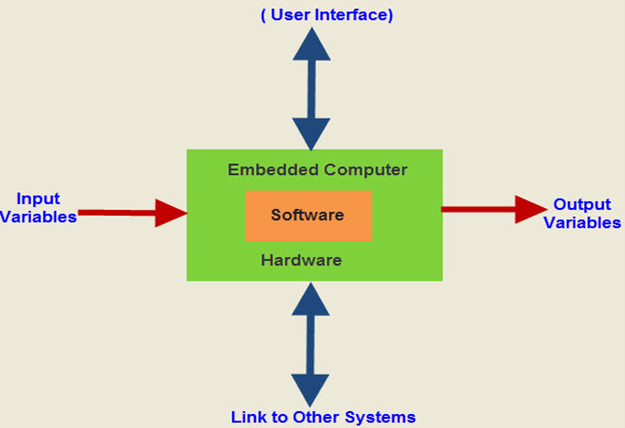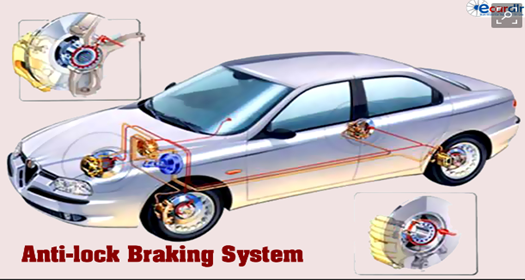
An embedded system is a system that consists of a software embedded in a hardware. It can be programmable or non-programmable depending on the application that we need. An Embedded system is defined as a way of working, assembling, performing single or multi tasks according to a set of rules.In such systems, all the units work together according to the software. Examples of embedded systems include numerous products such as ATM machine, washing machine, ABS, automobiles, airbag in vehicles, etc. The programming part of an embedded system can be microprocessors, microcontrollers as well as processors like DSPs.
The important features of embedded systems are speed, size, power, reliability, accuracy, adaptability. Therefore, embedded system performs can be used for real time applications when it is working at high speed. If the size and power consumption of the system is very low, then it can be easily used in different situations.
Since embedded system is a wide topic, it is hard to include everything in this blog. There are institutions that provide training in embedded systems, especially in Kochi that provide in depth training about embedded systems..
What is an embedded system?
An Embedded System can be defined as the combination of computer hardware and software. This system requires a hardware platform built with a microprocessor or microcontroller to where software can be installed. The Embedded system hardware includes units like user interface, Input/Output interfaces, display and memory, etc.Generally, an embedded system consists of counters, ADC, DAC, power supply, processor, memory, timers, serial communication ports and system application specific circuits.

In Embedded system software is written in high-level languages like C,C++,Javaetc and then it is compiled to achieve a specific function within a hardware. Embedded system software can be designed or edited by user.
Types of Embedded Systems
Embedded systems can be classified based on its performance, functional requirements and performance of the microcontroller.

Embedded systems divided based on their performance and functional requirements are given below:
- Stand alone embedded systems
- Real time embedded systems
- Networked embedded systems
- Mobile embedded systems
Embedded Systems classified based on the performance of the microcontroller are follows:
- Small scale embedded systems
- Medium scale embedded systems
- Sophisticated embedded systems
There are a lot of classifications when it comes to embedded systems. More classifications are discussed in embedded systems courses provided by institutions spread throughout the Ernakulam city.
Stand Alone Embedded Systems
Stand alone systems works in standalone mode. It takes input from the user or sensors, process the inputs and produce the required output. Inputs can be electrical signals from human or transducers and output can be electrical signals that can be used to drive some other systems. Embedded systems used in automobiles, process control, consumer electronics fall under this type. Examples: washing machine, power window, oven etc.

Real Time Embedded Systems
A real time embedded system is a system that produce a required o/p in specified time.These types of embedded systems are known as hard real time systems that follow the time deadlines strictly for the completion of a task. Example for hard real time systems are ABS,airbag etc. Real time embedded systems that does not need to meet the deadlines very strictly are called soft real time systems.

Networked Embedded Systems
The embedded systems that requires a network to access the resources. Networks can be LAN, WAN or the internet. The network connectionare either wired or wireless. This type of embedded system is one of the fastest growing area in embedded field. The embedded web server is a type of system where all embedded devices are connected to a web server and accessed and controlled by a web browser. Example for the LAN networked embedded system is a home security system wherein all sensors are connected and run on the protocol TCP/IP such as internet or company’s intranet. These systems run the protocol TCP/IP stack and get connected through PPP or Ethernet to a network and communicate with other nodes in the same network. Example for this type of system is weather monitoring system.

Mobile Embedded Systems
Embedded systems used in movable embedded devices like cell phones, mobiles, digital cameras, mp3 players and personal digital assistants(PDAs), are called Mobile embedded systems. Even though the PDAs do many general purpose tasks, they need to be designed just like the ‘conventional’ embedded systems. The limitations of the mobile devices like memory constraints, small size, lack of good user interfaces such as full fledged keyboard and display etc. are same as those found in the embedded systems discussed above. Hence, mobile devices are considered as embedded systems.

Applications of Embedded Systems:
Embedded systems are used in various areas like automobiles, telecommunications, smart cards, missiles, satellites, computer networking and digital consumer electronics.

Embedded Systems in Automobiles and in telecommunications
- Cruise control system
- Body or Engine safety
- Entertainment and multimedia in vehicles
- E-Com and Mobile access
- Robotics
- Wireless communication
- Mobile computing and networking
Embedded Systems in Smart Cards, Missiles and Satellites
- Security systems
- Telephone
- Banking
- Defense
- Aerospace
- Communication
Embedded Systems in Peripherals & Computer Networking
- Displays and Monitors
- Networking Systems
- Image Processing
- Network cards
- Printers
Embedded Systems in Consumer Electronics
- Digital Cameras
- Set top Boxes
- High Definition TVs
- DVDs
